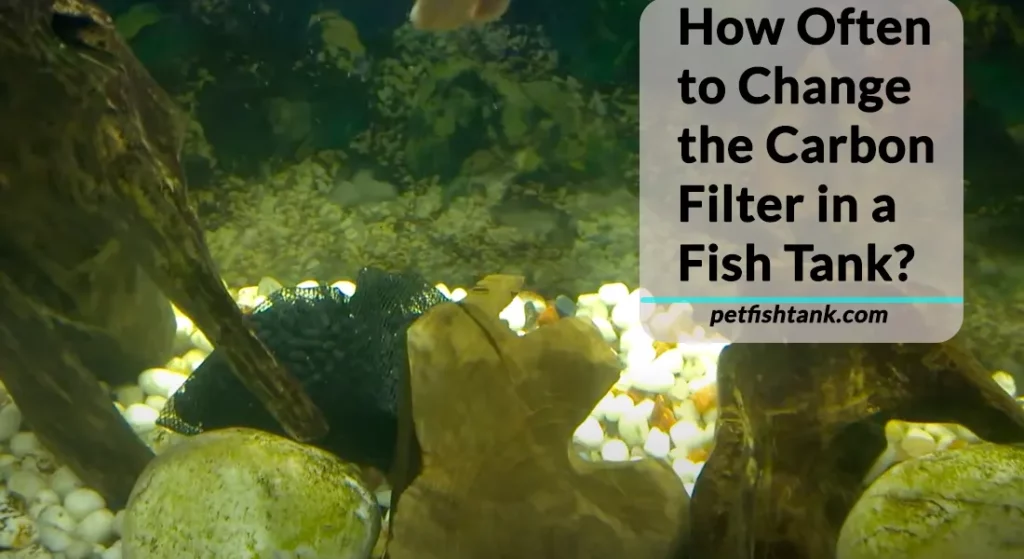Activated carbon or charcoal has been used to filter out many types of water and airborne contaminants. There are numerous choices available for freshwater aquarium filtration. The use of carbon filter media is among the most widely used filtration techniques.
Due to its extremely small pores, activated carbon makes an effective filter media. Chemicals can enter through these pores but cannot easily exit again.
In this section, several points have been discussed regarding the carbon filter in a fish tank along with the longevity of this filter and when to change it. So, hang in there and read the entire article.
Why Carbon Filter Is Used in Fish Aquarium?
Water is full of impurities like chlorine, phenolic compounds, and chloramines that are bad for the fish tank’s residents and degrade the water’s quality.
You can be confident that employing activated carbon will allow it to absorb these impurities and stop the water from growing yellow.

Which Particles Carbon Filters Cannot Eliminate?
Carbon filters cannot eliminate pollutants like nitrates, ammonia, and nitrites, which is another important point to be aware of.
Therefore, utilizing a carbon filter to eliminate these pollutants as you first build up the aquarium tank will be ineffective.
In addition, dangerous heavy metals cannot be eliminated by carbon filters or activated carbon. To address worries about the prevalence of heavy metals in the water, you will need to treat it with the appropriate product.
Reasons to Replace Carbon Filter
There is no longer room for new impurities to be held after the pores are full. Activated carbon cannot be compressed like a sponge to create extra space. Rinsing the carbon won’t get rid of the deposits either.
You will need to use fresh material in place of the activated carbon. Compared to making your own, buying activated carbon is simpler and more affordable.
Activated Carbon Replacement Symptoms You Should Be Aware of
There are three basic indications that it’s time to swap out your filter’s activated carbon.
Water is Not Much Clear
The fact that the water is not as clear as it once was will be among your first observations. Additionally, you will note that the water takes longer to clear of ultra-fine material if your fish often dig in the bottom.
Larger particles may still be removed by floss as well as other mechanical filter media, but it is the ultra-fine particles that contribute to the murky haze in the tank.
Bad Tank Water Smell
The smell of the storage tank will also alter, you’ll notice that second. Tank water shouldn’t typically smell. The water will begin to smell like corn tassels after activated carbon is fully absorbed.
Even so, the stench won’t be overpowering or spread across the space. There will still be a smell, but it will change from being plant-like to being earthier.
Change in The Water Color
The color of the water will start to change to yellowish, orange, or brownish. The water will become darker the longer you put off replacing the activated carbon.
The brown color might not be a positive factor unless the substrate is littered with garbage. It can be a warning sign that you need to deal with toxins and small particles in the water.
In this case, activated carbon might help the water look clearer, but it won’t stay long. The gravel must still be gradually vacuumed of debris, and living plants must be used to soak as much nitrate as you can.
How Often to Change the Carbon Filter In A Fish Tank?
There are many variables that affect how long the carbon remains in the aquarium filter.
The temperature at which the carbon is heated to activate it varies depending on the brand. The carbon filters can survive for 2-4 weeks, relying on the temperature at which it was charged.
The longevity of the carbon is also influenced by how pure the water is. The activated carbon won’t stay very long in unclean water. The corals in a reef fish tank will release biochemicals, which the carbon in the tank will absorb.
As a result, the carbon won’t be as stable as it might have been without corals. Depending on the existence of the bioload in the aquarium, you should replace the carbon in the aquarium filter every 2-4 weeks.
Keep in mind that the carbon will quickly lose its charge if there is a significant bioload. It should be added to the filter after the mechanical filtration material for this reason. By doing so, the carbon will be guaranteed to last a little while longer.
Alternate Sources of Activated Carbon
Depending on the aspect you want to replicate, you can choose an alternative to activated carbon.
- Use a thicker filter sponge or filter floss to reduce cloudiness.
- Zeolites can be used to lessen the yellow or brown tint in the water. Only keep in mind that zeolites also eliminate ammonia. The cycle of nitrifying bacteria can be disturbed if there is an excess of zeolite in the tank.
- Adding more live plants will help the water smell better. Anubias, aponogetons, and hornworts are all suitable for this use.
Frequently Asked Questions (FAQs)
Can activated carbon that has been used in aquariums be recharged?
How long will activated carbon be effective in an aquarium?
Without activated carbon, can an aquarium filter function?
Conclusion
The choice of whether or not to use carbon is entirely up to you. Both those who claim it is unnecessary and those who vouch for its efficacy are many.
Analyze your own aquarium to make your own decision. If you decide to use carbon, remember the advice above for a proper setup.
When you understand how activated carbon works, you will quickly see that there are more effective approaches to regulate aquarium water that do not rely on activated carbon all the time.
Related Posts:
